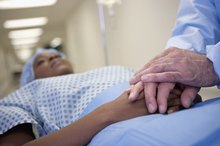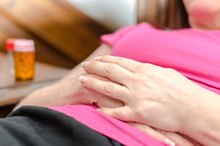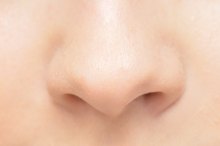Post Hemorrhoidectomy Complications
Hemorrhoids occur when the veins around the anus or lower rectum become inflamed and swollen. They can be located internally or externally around the rectum, and they are usually caused by straining during bowel movements, pregnancy, aging, chronic constipation, diarrhea or anal intercourse. Hemorrhoidectomy or hemorrhoid surgery is required when the veins around the anus become so swollen that they risk rupturing 2. During a hemorrhoidectomy, hemorrhoids are removed using a special stapler and then stitched together to allow for healing.
Intense Pain
Once the anesthesia wears off, patients may experience severe pain around the surgical site as the anus repeatedly tightens and releases. The pain is treated with medication that consists of opiate pain killers, such as morphine, which is usually delivered through an epidural, injection, intravenous drip or an internal pump inside the skin. It is believed that injecting the painkiller into the anal muscles during surgery can significantly reduce postoperative pain.
Bleeding
Complications From Hemorrhoid Surgery
Learn More
A complication of post hemorrhoidectomy is bleeding. Anal bleeds can occur when blood pools at the surgical site. The bleeding may be caused by small cuts from straining, infection, poor suturing during surgery or a ruptured blood vessel in the anus. Approximately 1 to 2 percent of people who have a hemorrhoidectomy experience delayed hemorrhaging when veins and arteries in the anal area fill up with blood and they rupture, according to Hemorrhoid.net. People with delayed hemorrhaging may start bleeding within seven to 16 days following the hemorrhoidectomy. Treatment usually requires hospitalization, one or more stitches and in some severe cases a blood transfusion.
- A complication of post hemorrhoidectomy is bleeding.
- People with delayed hemorrhaging may start bleeding within seven to 16 days following the hemorrhoidectomy.
Swelling and Difficulty Urinating
Some people may experience swelling near the surgical site that makes it difficult to urinate. A complication can occur when a person experiences pain and excess fluid around the surgical site following a hemorrhoidectomy. Approximately 20 percent of people experience the inability to urinate following hemorrhoid surgery, according to HemorrhoidsinPlainEnglish.com 2. Urinary retention usually clears up on its own in a few days, but in some severe cases, extended hospitalization and a catheter or drainage tube may be inserted to empty the bladder.
- Some people may experience swelling near the surgical site that makes it difficult to urinate.
- Urinary retention usually clears up on its own in a few days, but in some severe cases, extended hospitalization and a catheter or drainage tube may be inserted to empty the bladder.
Related Articles
References
- Medline Plus: Hemorrhoid Surgery
- American Academy of Family Physicians. Hemorrhoids. Updated November 10, 2017.
- National Institute of Diabetes and Digestive and Kidney Diseases. Symptoms & Causes of Hemorrhoids. Published October 2016.
- Lohsiriwat V. Hemorrhoids: from basic pathophysiology to clinical management. World J Gastroenterol. 2012;18(17):2009-17. doi:10.3748/wjg.v18.i17.2009
- National Institute of Diabetes and Digestive and Kidney Diseases. Diagnosis of Hemorrhoids. Published October 2016.
- American Society of Colon & Rectal Surgeons. Hemorrhoids.
Resources
Writer Bio
R. Y. Langham served as a senior writer for "The Herald" magazine from 1996-99. Langham holds a Bachelor of Arts in English from Fisk University, a Master of Science in marriage and family therapy from Trevecca Nazarene University and a Ph.D in family psychology from Capella University. Dr. R.Y. Langham published her first psychological thriller in September 2011. It can be purchased on Amazon.com, Barnes&Noble.com and Lulu.com.








